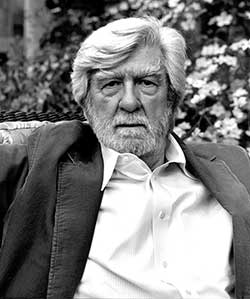
*
This week our guest columnist is noted Somerville literary critic Dennis Daly:
Against Sunset: Poems
by Stanley Plumly
W.W. Norton & Company
www.wwnorton.com
500 Fifth Avenue
New York, NY 10110
ISBN: 978-0-393-25394-8
84 pages – $25.95 Cloth

Stanley Plumly
Stanley Plumly hobnobs with dead people – romantic poets, contemporary poets, and personal relations. Whether citing real or imagined incidents from diaries or first-hand memories evoked from his past life, Plumly uses his verses to delve into the meaning of mortality and the mystery of life itself. He gently sorts out the strange draws and the nagging fears inherent in that “good night,” and explores those inclinations with a lyricism that mesmerizes his undaunted readers.
Two exquisite, airy pieces act as bookends to this collection. The opening poem, Dutch Elm, celebrates a suburbia of the mind, the dreamy paths leading to a mnemonic self-nullification. Plumly uses the majestic elm trees of his past life as his metaphoric, solace-delivering vehicle. The protective canopy of these trees shelter the poet’s most intimate moments and his deepest sorrows, a reality that shadows him like an afterlife. Here’s the lyrical heart of the poem,
I miss in particular the perspective looking down
the distances of all those Elm named streets disappearing
into dusk, the last sun turned the stained blue of church windows.
I miss standing there, letting the welcome dark make me invisible.
I miss the birds starting to sleep, their talking in their songs becoming
silent, then their silence. I even miss not standing there.
Against Sunset, Plumly’s title poem and the last piece in this impressive collection, extols the half-light of rising and setting suns. Speed matters as life lines up against the backdrop of horizon and sunset. The word “Against” in the title seems to take on an alternative meaning devoid of negativity. Plumly links the fall and rise of death and birth in his concluding lines,
The horizon, halfway disappeared between above and below—
night falls too or does it also rise out of the death-glitter of water?
And if night is the long straight path of the full moon pouring down
on the face of the deep, what makes us wish we could walk there,
like a flat skipped stone? I’ve seen the sun-path poured at dawn
on the flat other side of the country, but it was different, the yellow
morning red with fire, the new day’s burning hours oh so slowly climbing.
Within the depths of this book, many of the poems center on certain dead poets. In Mortal Acts Plumly reminisces about Galway Kinnell in a lovely narrative with a heartfelt point. But the real interesting part happens on the way to the aforesaid point. Here’s a taste of Plumly’s irony,
You hadn’t been there long, the job
at Binghamton meant traveling by bus
or driving to the center of the state
where the noir-in-color painter Edward
Hopper had once made lonely art of
Depression downtown buildings bleaker
than the rail yards and B&O freight cars.
In the end you couldn’t do it, drive or take
the bus, be that tired again, so you won
the Pulitzer and efficiency apartment
that goes with full professorships at nearby
NYU, as close as you could get to home
in faraway Vermont.
Replete with multiple caesuras in the form of dashes, Plumly’s To Autumn, which he bases on letters from John Keats to Richard Woodhouse and John Hamilton Reynolds, chronicles Keats’ poetic walks that served up the heavily-misted landscapes for that poet’s piece Ode to Autumn. Plumly knows whereof he speaks—he has written a book on John Keats. The poet fastens many of Keats’ insightful quotations together with explanatory phrases and connective words. The process works spectacularly well. The poem opens this way,
A walk along the water meadows by the playing fields
of the college—a mile-and-a-half to the hospice
of St. Cross—a walk he takes almost every day
in the “pleasantest town I was ever in,”
including a Sunday named for the sun cutting angles
with its scythe, when it strikes him just how beautiful
the season has become here at the end of summer,
the gathering of light, the harvest coming in,
“chaste weather—Dian skies… a temperate sharpness.”
He writes Reynolds that he “never liked stubble fields
so much as now…
Keats’ aforementioned letters were written a year and a half before his death.
Set in the heart of this collection, Plumly’s thirteen-section poem, Early Nineteenth Century English Poetry Walks, amazes with its mosaic of famous lives pieced together by a twenty-first century denizen not unfamiliar with pastoral romance. Keats appears again, as does William Wordsworth, Samuel Taylor Coleridge, essayist Charles Lamb, Thomas Chatterton, and others. The constant movement of these artists in their walkabouts mimic their imagined realities and their romanticized fates. Each of the thirteen poetic sections is thirteen lines long. How unlucky! Section 11 explores the very nature of these walks. Consider these lines,
Walks. Coleridge walks, at his best, through abstraction thick as glass,
toward what Hart Crane calls “an improved infancy,” both his sons’s
and his own. There is no stopping Coleridge. Shelley, “borne darkly,
fearfully, afar,” tries to walk on water, “far from shore.” Keats,
in the thousand days before the end, walks in ever-closing circles
Sounds a bit like an academic exercise, doesn’t it? Well, it’s not. Plumly seems to know exactly what he’s doing. He has reached back into the nineteenth century and grabbed hold of these melancholic constructions of country landscape, which have been disused in our new century, sets them in place, and then employs this context as a framework to his contemplation of mortality. Plumly then weaves his own personal contacts and concerns into this emotional panorama. The poetic consequences of these strategies both enlighten and comfort readers of this subtly-layered, rewarding book.
— Dennis Daly












Reader Comments